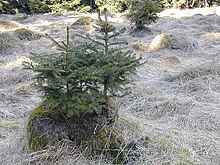Deadwood regeneration
Deadwood regeneration , also sometimes called softwood regeneration , carcass regeneration or Rannenrejüngung , describes a form of natural regeneration in forestry in which the seeds of forest trees germinate and grow on decaying wood of dead trees . Deadwood regeneration is particularly important in mountain forests and on heavily grassed sites.
For deadwood regeneration to be successful, the rotting trunk or stump must have reached a certain degree of decomposition. This happens through insect and fungal attack. During the decomposition, nutrients are made available to the seedling. However, only if the wood has a certain level of moisture over a certain period of time, regeneration is possible in such small habitats that are favored by the location . As the plant continues to grow, the roots penetrate the decaying wood and the grass layer and come into contact with the mineral soil below, which enables further growth.
literature
- Norbert Bartsch, Ernst Röhrig: Forest ecology: Introduction for Central Europe . 1st edition. Springer, Berlin, Heidelberg 2016, ISBN 978-3-662-44268-5 .
